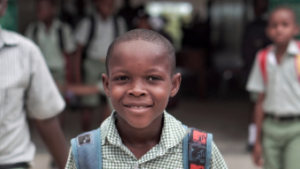Uplifting the Voices of Students of Color Through Restorative Practices and Civic Engagement
By Jessie Tobin, Aaron Leo, & Kristen C. Wilcox
On January 20th, 22-year-old Amanda Gorman delivered her inaugural poem to the nation and world. She reminded listeners of the power of young people’s voices and the importance of telling and hearing the stories of young Black people. Her poem brings to the fore a timely and important question: How might educators redouble their efforts in lifting up the voices of young people of color who are still waiting to share their stories? At Malverne Senior High School, a culturally and racially diverse positive outlier school from NYKids’ latest study, educators and school leaders provide insights into how students’ voices can be highlighted.
Student Voice and Restorative Justice
A recent article published by the Center for American Progress, describes ways listening to student voice can provide valuable “input in their education ranging from input into the instructional topics, the way students learn, the way schools are designed, and more.” In schools, educators can lift up student voice through varied methods such as eliciting students’ perspectives and feedback through surveys, personalizing learning to fit students’ interests, including students in school decision making, and facilitating student-led research and projects.
Fostering student voice can have powerful effects on engagement as students who take ownership over their own learning are more likely to enjoy being in school. Including students’ voices also can have democratizing effects on both schools and classrooms as diverse perspectives are folded into how problems are framed and what solutions are then proposed.
 Providing spaces for students to voice their opinions and address issues affecting their lives can empower students to effect positive change in their communities. Such opportunities are particularly crucial for students of color whose voices, resources, and knowledge have historically been marginalized in and outside of schools.
Providing spaces for students to voice their opinions and address issues affecting their lives can empower students to effect positive change in their communities. Such opportunities are particularly crucial for students of color whose voices, resources, and knowledge have historically been marginalized in and outside of schools.
Restorative justice offers a set of principles and strategies that center on voicing where harm has been done and using diverse voices to identify resolutions. In school settings, restorative justice practices include inviting young people to lead conversations, share ideas, reconcile with one another, listen to their peers, and have their voices heard without fear of judgement, and are growing in popularity. Since research has shown that traditional methods intended to change student behaviors have often furthered injustices for young Black students in particular, restorative justice provides a viable human-centered alternative approach. Restorative justice practices encourage a preventative posture and focus less on direct responses to challenging behaviors and more on fostering respectful relationships and inclusive climates in schools.
Spotlighting Student Voice at Malverne High School
As documented in our previous reports as well as our recent cross-case analysis, educators at Malverne High School encourage students to voice their opinions on school-related topics as important issues facing their lives and communities.

Even with the move to remote learning, educators at Malverne have continued to encourage students to voice their opinions on pressing social issues. In a recent NYKids team meeting, for instance, Malverne’s principal Dr. Vincent Romano reflected that being away from students in the aftermath of the killing of George Floyd was particularly challenging for his staff members. Once school was back in session, educators initiated Talking Circles – a restorative practice that gives students opportunities to share their concerns or ideas with peers and educators. While discussing racial injustice has been difficult, Dr. Romano noted that emotions have been further charged by the fact that students are also experiencing a global pandemic at the same time with disproportionate impacts on communities of color.
For the students at Malverne, Talking Circles give them a platform to share their thoughts and concerns in response to current events that may feel overwhelming. As Dr. Romano explained, “Give students a platform, and they will tell you.”
For more information on Civic Engagement and Restorative Justice practices, please visit our Resources page and the links below. Also, please visit our webpage for reports on Malverne High School and other positive outlier schools around New York state. We encourage you to sign up for our Newsletter and reach out to us with feedback at nykids@albany.edu.
Additional resources on Restorative Justice:
Restorative Justice Resources from Edutopia
Restorative Justice – What Teachers Need to Know
Communities for Restorative Justice
The Power of Restorative Practices – from AATLAS
Information on Talking Circles from the University of Michigan
